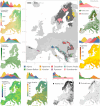Human Footprint and Forest Disturbance Reduce Space Use of Brown Bears (Ursus arctos) Across Europe
- PMID: 39749588
- PMCID: PMC11696834
- DOI: 10.1111/gcb.70011
Human Footprint and Forest Disturbance Reduce Space Use of Brown Bears (Ursus arctos) Across Europe
Abstract
Three-quarters of the planet's land surface has been altered by humans, with consequences for animal ecology, movements and related ecosystem functioning. Species often occupy wide geographical ranges with contrasting human disturbance and environmental conditions, yet, limited data availability across species' ranges has constrained our understanding of how human pressure and resource availability jointly shape intraspecific variation of animal space use. Leveraging a unique dataset of 758 annual GPS movement trajectories from 375 brown bears (Ursus arctos) across the species' range in Europe, we investigated the effects of human pressure (i.e., human footprint index), resource availability and predictability, forest cover and disturbance, and area-based conservation measures on brown bear space use. We quantified space use at different spatiotemporal scales during the growing season (May-September): home range size; representing general space requirements, 10-day long-distance displacement distances, and routine 1-day displacement distances. We found large intraspecific variation in brown bear space use across all scales, which was profoundly affected by human footprint index, vegetation productivity, and recent forest disturbances creating opportunity for resource pulses. Bears occupied smaller home ranges and moved less in more anthropized landscapes and in areas with higher resource availability and predictability. Forest disturbances reduced space use while contiguous forest cover promoted longer daily movements. The amount of strictly protected and roadless areas within bear home ranges was too small to affect space use. Anthropized landscapes may hinder the expansion of small and isolated populations, such as the Apennine and Pyrenean, and obstruct population connectivity, for example between the Dinaric Pindos population and the Alpine or Carpathian population. Our findings call for actions to maintain bear movements across landscapes with high human footprint, for example by maintaining forest integrity, to support viable bear populations and their ecosystem functions.
Keywords: Ursus arctos; GPS telemetry; anthropocene; connectivity; human footprint; intraspecific variation; movement; resource availability.
© 2025 The Author(s). Global Change Biology published by John Wiley & Sons Ltd.
Conflict of interest statement
The authors declare no conflicts of interest.
Figures





References
-
- Abrahms, B. , Carter N. H., Clark‐Wolf T. J., et al. 2023. “Climate Change as a Global Amplifier of Human–Wildlife Conflict.” Nature Climate Change 13, no. 3: 224–234. 10.1038/s41558-023-01608-5. - DOI
-
- Bartoń, K. A. , Zwijacz‐Kozica T., Zięba F., Sergiel A., and Selva N.. 2019. “Bears Without Borders: Long‐Distance Movement in Human‐Dominated Landscapes.” Global Ecology and Conservation e00541: e00541. 10.1016/j.gecco.2019.e00541. - DOI
MeSH terms
Grants and funding
LinkOut - more resources
Full Text Sources
Miscellaneous

